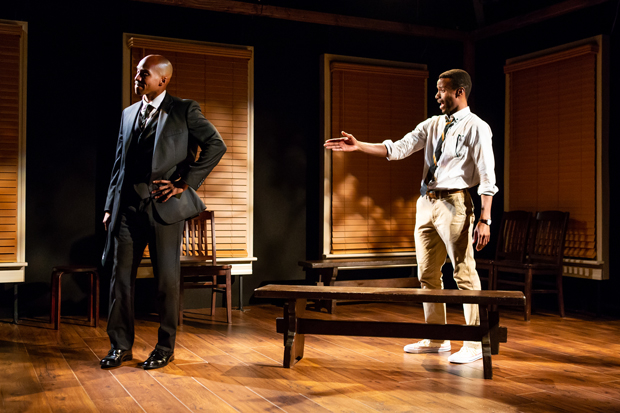A Debate Over How to Fight for Social Justice in Travisville

(© Jeremy Daniel)
Travisville, the new play by first-time playwright William Jackson Harper (TV's The Good Place, After the Blast) having its world premiere at Ensemble Studio Theatre, is a coproduction between that theater company and the Radio Drama Network. Perhaps the participation of the latter in the development of this play helps explain its exceedingly talky nature. This dramatization of inflamed political, religious, and racial tensions in the fictional church community of Fannin Gardens in 1964 abounds in discussions of political ideologies and practical strategies, with the occasional personal anecdote to help explain where these characters' worldviews come from.
The nub of these conversations is the larger question of how African-Americans should proceed in American society in the wake of the passage of the Civil Rights Act of 1964. Alden Hearst (Brian D. Coats), the outgoing elder minister at the New Mount Olives Pentecostal Church, represents a moderate path, working with white Mayor Ainsley Gillette (a blunt but not wholly unsympathetic Denny Dale Bess) to keep the peace between whites and blacks in their community, especially as land developer Jaston Honeycutt (also Bess) plans to redevelop the area into the wealthier Travisville project, thus threatening to displace the residents of Fannin Gardens.
The appearance of the young firebrand Zeke Phillips (Sheldon Best), however, throws a wrench in their efforts. Suggesting a more revolutionary approach, he shakes up not only society at large but also minister Ora Fletcher (Bjorn DuPaty), the ambivalent heart and soul of Travisville. Fletcher is conflicted between his desire to maintain the current truce and his acknowledgment that perhaps Phillips's incendiary route is the only way to enact real change in American race relations.

(© Jeremy Daniel)
In order to keep our attention focused on these characters and their debates, director Steve H. Broadnax III encourages a sense of simplicity and naturalism in the design elements. Milagros Ponce de León's one-room set consists only of two benches, two chairs, a long table, and a pulpit, all of which the actors move around during scene changes. Notwithstanding a couple of flashing-light effects, Adam Honoré's lighting denotes changes in time and place rather than particular moods. And Suzanne Chesney's costumes strive for authenticity regarding the characters' respective vocations: conservative suit-and-tie outfits for many of the political and religious figures, T-shirts and overalls for the working-class male characters, and flowing dresses and aprons for the working-class female characters. (Broadnax's handling of scene changes — with characters from the next scene overlapping with the current one in a way that suggests a stage version of a cinematic dissolve — is his only mildly inventive directorial touch.)
Such relatively hands-off direction puts much of the onus on the dialogue and actors to carry the day. Thankfully, Harper shows a knack for colorful dialogue throughout: funny at unexpected moments, eloquent during serious ones. And the cast bring a dynamism to their roles that feels positively electric in the Curt Dempster Theatre's intimate small space. DuPaty's anguish as the equivocal Fletcher contrasts strikingly with Coats's rough authority as Hearst and Best's fiery passion as Phillips. As for the rest of the cast — with some of the actors playing multiple roles — Lynnette R. Freeman stands out as Georgia Dawson, wife of local body-shop owner Orthell (a poignantly desperate Shawn Randall), who delivers a heartbreaking monologue directed at Honeycutt in the second half. Stori Ayers, meanwhile, radiates warmth and patience in the somewhat thankless part of Fletcher's loyal wife, Bethany.

(© Jeremy Daniel)
Perhaps most impressive about Travisville, however, is Harper's clearheaded willingness to embrace the agonizing complexities of his subject. Though there's little doubt that he believes in Zeke's brand of progressivism, that doesn't mean he isn't sympathetic to the other, invariably older characters' comparable timidity. For townsfolk like the Dawsons, keeping the peace in Fannin Gardens is a matter of pure survival; for Mayor Gillette, it's the hope of creating jobs in the economically depressed community. For Hearst, Fletcher, and others, it's the broader hope that the country is truly on the verge of a postracial society — a hope that the much younger Zeke sees as still a pipe dream. But in Travisville, even Zeke's idealism finds its limits when he witnesses death up close — a brush with tragedy that threatens to kill his resolve.
A humane attention to real-world nuance infuses Harper's play with genuine emotional stakes beyond the political strategizing — a sense of messiness that is reflected in sound designer Shane Rettig's use of samples of frenzied, dissonant Ornette Coleman music in between some of the scenes. Travisville sounds an ostensibly hopeful note — with one character repeatedly telling another, "We will be okay" — but, like the peace in Travisville at the beginning of the play, it's that sense of tenuousness that unsettlingly lingers as the lights go black.

(© Jeremy Daniel)










